
Version: January 18, 2009
 |
|
|
Version: January 18, 2009 |
|
Being a bit of a home-grown engineer, I enjoy reading stories of how things were built. When making my first phonograph, I had no intention of giving such an account, but now with the Model 2 under way, I will write as progress is made. So here is the story, dead ends and false starts included: The idea was to make a player as simple as possible, making use of existing parts. Its essential features would be a pivoting tone arm that can be raised and lowered to take different size cylinders, and enough space around the mandrel to take slip-on mandrels for larger cylinders. I began to plan it at a time when my mind was well off the obligations of daily life at home, and made a drawing. Finding myself far from any of the parts I intended to assemble, this drawing displays some degree of wishful thinking. Above all, the player is not drawn nearly as wide as it has proven to be in real life.
| |
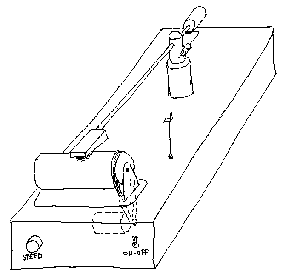 |
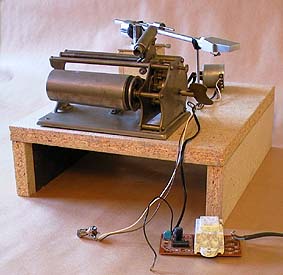 |
| The first drawing, made on vacation in Chile in early 1999 | The first test rig, with a Graphohpone Q. It made a horrendous noise. |
|
The tone arm is from an old Lenco turntable that has been resting peacefully in my basement for the last decade or more. It is a fairly heavy arm, and straight, as it should be when playing cylinders. But this also means the pickup shell holds the pickup at an angle to the arm, so I had to saw it to two pieces and glue it together straight. It does not look very nice, and possibly will not even stay in one piece once it is put to use. As a cylinder's playing surface will be placed higher than a disc, I had to mount the tone arm some distance above the base plate. I chose to set it on a small turret, as I did not know exactly how high it would need to be raised. The vertical pillar with the arm's bearings can be moved up and down. It is held in place by a small screw on the right side of the ring that is attached to the baseplate (or in this case, a turret). I replaced the screw with a longer one in order to be able to raise and lower the tone arm easily if need be. As the arm was now higher than in its original design, the arm rest was too short to serve its purpose. I made a longer one, which can also be adjusted if I would need to mount the tone arm at a different height. The motor is from a simple plastic turntable I don't even remember the name of any more, but it had adjustable speed. This is an essential feature of any cylinder player, and I had to extend the range of speeds to accomodate for the differences between recorded cylinders. At the beginning, I intended to use my old conversation piece Graphophone Q (the one at the head of every page on this site) to avoid having to make a new mandrel. So I just put the belt from the plastic turntable around the motor pinion and the Graphophone mandrel and turned on the current. The noise it made was absolutely horrendous.
| |
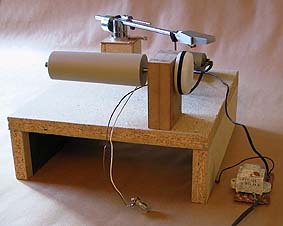 |
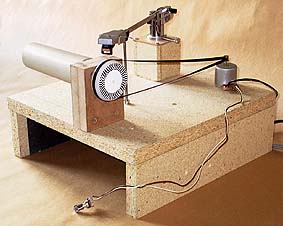 |
| The phonograph with the Chamoux mandrel and the motor horizontal. | Third attempt, the motor now vertical, the mandrel moved a bit to the left and spinning in the right direction. |
|
Henri Chamoux got me out of the problem by actually sending me a mandrel with shaft and mount and pinion. Beautiful work, and very silent. The mandrel is long enough to accomodate cylinders of slightly different inner dimensions. When first trying it out, a splitting Blue Amberol made me believe it was too thick to take on the cylinders in my collection, but when setting it up to take some of these pictures, I discovered the thickness is quite right. Speed is read by a stroboscope produced with Strob-Exec, a DOS program written by Adrian Hindle-Briscall, see my stroboscope page. In order to make the player as small as possible, I wanted to orient the motor horizontally with the pinion pointing outward. However this meant the motor was spinning in the wrong direction. I thought it would be an easy thing to just switch the power wires to make the motor reverse. And it was, only the speed control ceased to function, and mandrel speed was a solid 200 rpm at all times. So I switched the wires back and put the motor in a a vertical position with the belt going through an angle of 90 degrees. This works quite well, and is the way the motor was originally oriented in the gramophone. Then to the test! I set up the player on a gramophone near my amplifier, put a Blue Amberol on the mandrel and started the motor. 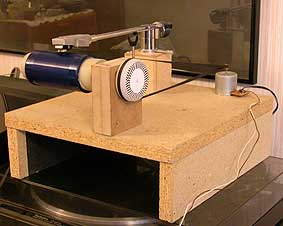 At first, the stylus tended to skid across the grooves, but after some adjustment of tonearm height it kept in track. I set stylus pressure so high that the body of the Shure M 75 MB pickup would only just clear the cylinder. I don't know exactly what the pressure was, as I had lost the counterweight adjustment weight, but it was a rather high pressure. While the stylus stayed in the groove, the tonearm tended to behave much like an old American car, swinging around in an irregular solo dance somewhere above the ground. Unfortunately this gave an audible effect, the sound from the player war unpleasantly pulsating. In view of the results, I finally decided the pivoting arm is probably not such a good idea. Some phonograph makers have apparently reached good results with a pivoting arm, but it seems the construction is very sensitive to resonance given cerain combinations of stylus resilience, tone arm mass and length and so on and so forth. Anyway, I am not prepared to try to find out just why my particular attempt did not work out, and the remains of my experimenting are now with another builder with a different approach. Let's see what comes out of that. Christer Hamp, 2000-2009 | |

